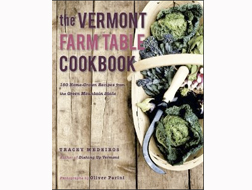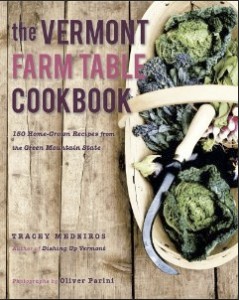
The Vermont Farm Table Cookbook, 150 Home-Grown Recipes from the Green Mountain State, by Tracey Medeiros. Photographs by Oliver Parini. 254 pages. Paperback. Published by the Countryman Press, Woodstock, Vermont. $19.95.
This is a cookbook that was just waiting to be written. Given Vermont’s attention to local food, diversified agriculture, and family farms, the only wonder is that someone didn’t write it earlier.
The Vermont Farm Table combines recipes with short profiles of the farms, breweries, farmers markets, and restaurants the recipes, and many of their ingredients, come from. It’s also a picture book. Lots of cookbooks include photographs of food that make your mouth water. This one does, too, but in addition, it’s a Vermont Life-style photo show of forests, fields, gardens, and farmers.
Predictably, there’s a lot of “brand” ingredients involved here. For instance, it’s likely possible to make a fine New York strip steak without WhistlePig whiskey, but if it doesn’t turn out to be quite the dish you’d envisioned, you can probably blame the cheap brand of whiskey you used instead of WhistlePig.
It’s about time to say here that I have theories about cookbooks, the main one being that the best cookbooks — the most worn ones on my shelves — tell you how to put together ingredients you’re likely to already have in tasty ways you haven’t thought of before.
To a large extent, this book does that. The maple-glazed sweet potatoes with walnuts and cumin that we made Thursday night were terrific, easy to prepare and didn’t even require a trip to the store. The recipe comes from Square Deal Farm in Walden, owned by Sarah Lyons and Ray Lewis, sugarmakers who also raise Pinzgauer cattle and pasture fed pigs.
There are lots of recipes in this book that are as simple and inexpensive: for instance, asparagus and brown rice from Pomykala Farm; Full Moon Farm’s hearty toasted sandwiches with heirloom tomatoes; Kimball Brook Farm’s hefty corn chowder; Butterworks Farm’s maple cornbread; Longview Farm’s leg of lamb; or the amber ale-braised highland beef chuck roast from Shat Acres in Greensboro Bend.
But be prepared to shop as well as cook if you plan to use this book, which may be part of its purpose.
It also helps to be a gardener. Some of the simplest recipes rely on ingredients you’ll find at a farmers market, or in your own garden, but probably not at Price Chopper.
For instance, there’s no way that Full Moon Farm’s hearty toasted sandwiches are going to be as tasty without Brandywine tomatoes, which you’re highly unlikely to find in a grocery store, given their relatively short shelf life, odd color, and lumpy shape. Grocery stores, and the growers who supply them, long ago traded in flavor for longevity and appearance.
But I think it would be fair to assume that a major purpose of this particular cookbook is to introduce local ingredients, as well as their sources, the idea being to reconnect people to good food and where it comes from.
Author Tracey Medeiros is marketing Vermont and its farmers here, but also providing Vermonters themselves with information about where to find fresh, local meat, produce, cheese, fruit, and maple products — and what to do with them.
Not surprisingly, the weakest section of the book is that which deals with seafood, Vermont not being known for its fresh scallops and shrimp. But the main reason I say that is because the recipes tend to come from restaurants rather than from farmers, and are thus more complicated.
Yes, I would love to make butter poached halibut with forbidden black rice, beet dashi, and fennel salad, but I have no idea where I’d get two fennel bulbs, stalks removed, bulbs trimmed, and a cup of dried shitake mushrooms, as well as two star anise pods.
That recipe comes from a Burlington restaurant, rather than a farmer — a restaurant that’s committed to fresh, local food, but the recipe does not suggest where the ingredients might be found. Most cooks, outside of chefs, aren’t likely to traverse the state in order to locate what they need for dinner.
Some of the ingredients called for in this book include vanilla bean paste, root of celeriac, hulled hemp seed (isn’t that illegal?), arrowroot, fennel bulbs, and pomegranate molasses.
Like I said, you might have to shop in order to use this cookbook.
As a book about Vermont farmers, it succeeds admirably. The brief profiles are of people who grow, raise, or prepare Vermont food in all its fresh diversity. We all know that superior maple products, great apples, a variety of cheeses, and grass fed beef and free range poultry are grown here. But cranberries? Rabbit? Flowers?
As a cookbook, for the most part, it approaches cooking with solid but creative ideas about how to use the wealth of local products that Vermont has to offer. The Vermont Farm Table is better than many I own and seldom open unless I have a rare day to spend hours in the kitchen.
I can’t wait until the squash crop comes in and we get to prepare grilled coconut delicata squash, or roasted root crops, or winter squash with roasted garlic.
contact Tena Starr at [email protected]
For more free articles from the Chronicle like this one, see our Reviews pages. For all the Chronicle’s stories, pick up a print copy or subscribe, either for print or digital editions.








